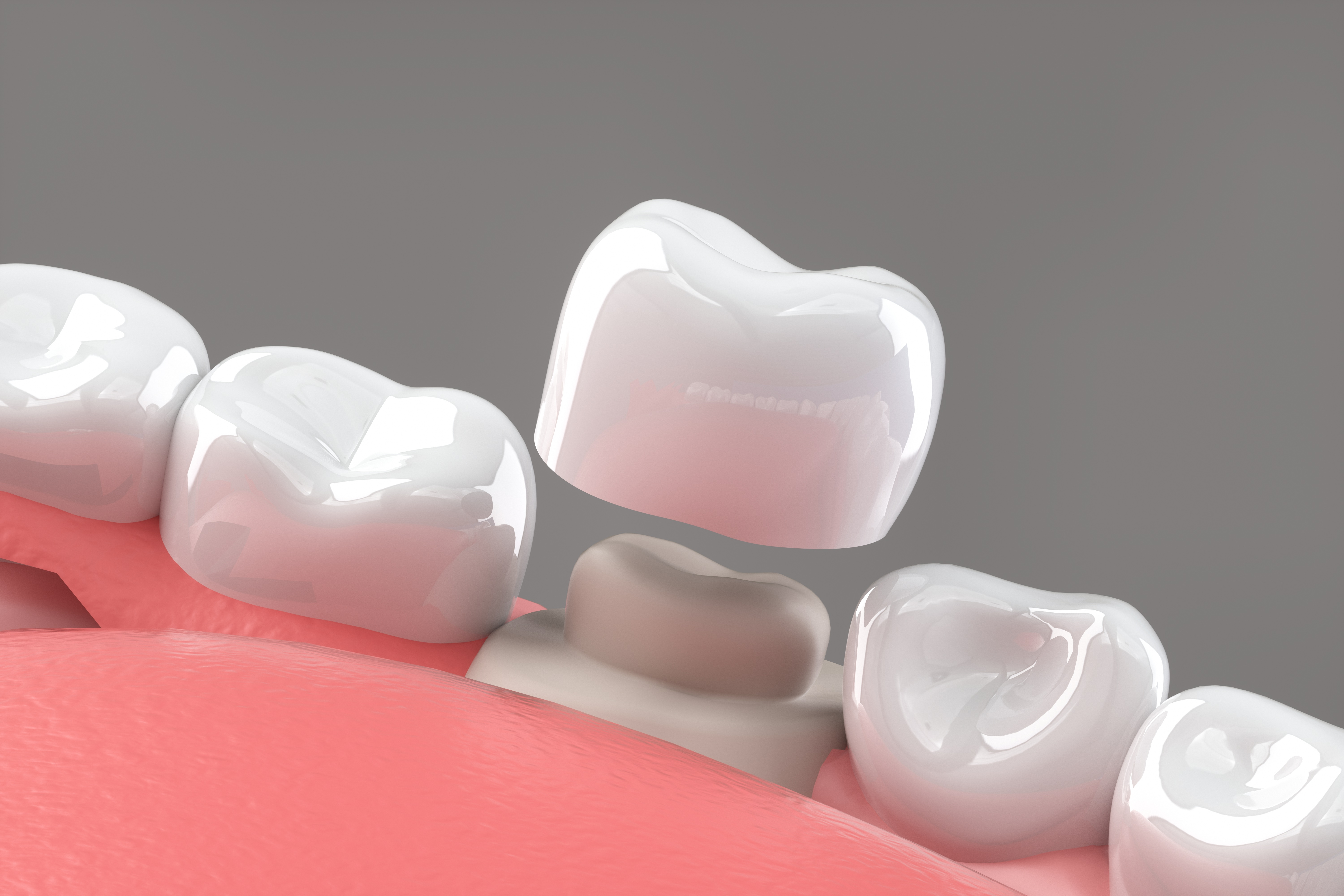Blog Details
Complete guide on Dental crowns

Dental Bridges, Crowns & Implants Explained
A crown or cap covers a single tooth, a bridge covers multiple teeth, and implants replace missing teeth. Dental implants can replace single, multiple, or entire arches of missing teeth. All these replacements substitute for missing, damaged, and broken teeth. Many conditions can lead to the loss of teeth, from decay to gum disease. Also, a crown supports a root canal-treated tooth after the treatment. We will examine the various types, their placement, adjustment procedures, and functionality.
What are Crowns & Bridges?
Dental crowns and bridges cover a damaged, chipped, lost, broken or weakened tooth. A crown is made for a single tooth, but a bridge requires two or more crowns. It covers two or more teeth in a row. In a bridge, support is taken from the adjacent teeth (also called abutment teeth) on either side of the gap created by the lost tooth. Crowns and bridges provide strong and long-lasting teeth replacement solutions. They are custom-made artificial teeth caps that restore damaged, lost or decayed teeth's shape, size, strength, and appearance.
- Metal crowns
- Metal ceramic crowns
- Metal-Free crowns
-
Metal Crowns:
They are dental crowns made primarily of various metal alloys. These crowns are known for their durability and strength. They can easily bear chewing and biting forces. However, metal crowns have a metal look that may be less appealing than natural tooth-coloured options such as porcelain or ceramic ones. As a result, they are used for back teeth or areas that are less visible when smiling. Full cast non-precious crowns are a type of metal crown. They are made of non-precious metal alloys like nickel-chromium or cobalt-chromium. They are not suitable for everyone as they can cause metal allergies in some. High noble alloys can also be used for making dental crowns. Titanium is generally a safe and non-allergic metal for dental restorations. However, titanium is more popularly used for dental implants than crowns. The cost of making titanium crowns is higher than that of other metal crowns as specialized techniques and equipment are needed to make these metal crowns.
-
Metal-Ceramic Crowns:
They are also known as porcelain fused to metal (PFM) crowns. They are made of a metal base with a ceramic covering. The metal base is made from alloys like nickel-chromium or cobalt-chromium, and the outer layer is made of dental porcelain fused to the metal. The metal base strengthens the crown, and the porcelain cover helps the crown blend with the natural teeth. Hence, porcelain crowns look natural and are not as visible in the mouth as metal ones. These crowns are suitable for front and back teeth as they resemble the tooth's colour. However, PFM crowns are not suitable for all, as the metal base can cause allergies in some. It gives a slight greying effect at the gum line due to the underlying metal framework. Also, PFM crowns can chip and fracture over time.
-
Metal-Free Crowns:
Non-metal crowns are made entirely of porcelain/ceramic materials, giving them a more natural appearance. Zirconia ceramic crowns are more popular nowadays because of their strength and durability. They are comfortable, non-allergic, and do not cause sensitivity. These crowns are designed with CAD/CAM technology that fits perfectly well and gives a natural look. Certified zirconia crowns are the safest for teeth replacement. Illusion Zirconia Dental Crowns are one of the most reliable crowns. Illusion Zirconia Life dental crowns come with a lifetime international warranty. These crowns can last a lifetime with proper care and follow-ups.
How Crown Placement and Adjustment Is Performed?
-
-
- Dental crown placement and adjustment are essential for the crown's proper fit, function and durability. A proper crown placement and adjustment procedure involves the following steps.
- First, the dentist prepares the tooth for any damage or decay. Secondly, they take impressions or digital scans of the mouth and send them to the lab for crown preparation. A temporary crown is placed on the tooth to protect it from further damage.
- The dental lab prepares the crown mostly within a week after receiving the digital scans or impressions from your dentist.
- After the dental laboratory prepares the permanent crown, it is then sent to your dentist. Your dentist schedules a crown seat dental appointment. During this seating, your dentist removes the temporary crowns and fixes your custom-made, permanent crown.
- Next, the dentist will ensure the crown fits perfectly on the tooth. It should achieve proper crown margins and bite during the crown seating. To achieve a better fit and aesthetic result, the dentist may need to make crown adjustments or replace the crown if it is an under-contoured crown or has some other problem, including issues with tooth colour, size and shape of the tooth. At times, due to too much adjustment, the crown may feel submerged in the gum line.
- The dentist further ensures that the crown achieves the required crown margin and fits the prepared tooth precisely. It reduces the risk of decay and infection by keeping bacteria and debris out of the space between the crown and the tooth.
- When the crown feels satisfactory, the dentist permanently fixes the crown onto the prepared tooth structure with dental cement or adhesive.
- After the placement, the new crown feels tight at times; this discomfort resolves with slight adjustments, and the discomfort subsides within a few days as the patient adjusts to the new crown. If any problem persists, you can call your dentist and schedule an appointment to resolve your concern.
-
Types of Dental Bridges
-
-
- Traditional bridges: A traditional dental bridge fills the space left by a missing tooth by using crowns on adjacent teeth to fix a false tooth securely in between.
- Cantilever bridges: A cantilever bridge uses one adjacent tooth (abutment tooth) to support a false tooth. This kind of bridge is used when there's only one adjacent tooth next to the missing teeth.
- Maryland bridges: A Maryland bridge is made of metal or porcelain wings. These wings bond with the adjacent teeth to support a false tooth. It is often used to replace front teeth.
- Implant-supported bridges: An implant-supported bridge uses dental implants as a base to support false teeth. The implants are covered with dental crowns. Dental implants provide a long-lasting and durable solution for missing teeth.
-
Types of Implant Crowns
-
-
- Dental implants are artificial roots that support false teeth. Implant crowns cover these dental implants. An implant consists of three parts: a screw made of metal, an abutment and a dental crown. The screw is generally made of titanium, palladium, or platinum. The metal screw is surgically implanted in the jaw, acting as a tooth root, and is protected by an abutment. It is covered by a custom-made tooth cap or dental crown. The dental crown that covers the implant is called the implant crown. Here's an overview of implant crowns: Implant crowns can be divided into several types based on various factors, such as materials, fabrication methods, and attachment mechanisms
- The types of implant crowns can be divided into metal, metal-ceramic, all-ceramic zirconia, hybrid or resin crowns, etc.
- Based on the fabrication method, the implant crowns are divided into cement-retained or screw-retained implant crowns.
- The material is the same. However, they have different names, like implant-supported crowns or implant-supported porcelain crowns.
-
Based on the Fabrication Method
1. Screwmentable implant crown:
A screw-retained crown is a type of implant crown screwed to the implant. The crown has a hole in the biting surface that allows the screw to be tightened directly onto the implant abutment. This method allows for simple extraction of the implant crown because it can be removed by simply removing the screw. It also allows adjustments to the crown. However, the access hole is visible in such crowns, which can be an aesthetic concern
2. Cement-retained implant crown:
A cement-retained crown, also known as an implant-retained crown, is cemented to the implant abutment using dental cement for a secure bond. Implant-retained crowns are more visually pleasing because there is no visible access hole on the crown's biting surface. However, if the crown needs to be removed or replaced in the future, it has to be cut or drilled off, which may damage the crown or abutment.
Which Is Better, Cement or Screw-Retained Implant Crown?
The decision between a screwable implant crown and a cement-retained implant crown depends on several factors. It can include the clinical situation, beauty concerns, ease of removal, and the dentist and patient's preferences. Your dentist will evaluate your situation and advise you on the best option for your implant crown.
Implant Crown Delivery Steps
Several procedures are followed while delivering an implant crown to guarantee proper fit, appearance, and functionality. Here are the typical steps in the delivery of an implant crown:
-
The dentist will examine the implant site and surrounding tissues to ensure they are sound and prepared for the final fitting before the crown is delivered. Your dentist will examine the abutment's fit, determine the bite, and ensure it blends with your natural teeth.
-
The dentist will use shade guides to choose the right shade that complements the patient's natural teeth. Hence, factors like tooth colour, translucency, size, and shape of the adjacent teeth are considered before making your dental crown.
-
The implant crown is created in a dental lab using impressions or digital scans of the implant site. It is designed with advanced technology using CAD/CAM software. This helps to give the crown a precise fit and helps to meet beauty concerns while replacing missing teeth or damaged teeth.
-
The dentist schedules the try-in appointment for the patient and checks the crown's fit, natural look and alignment.
-
The dentist makes the necessary changes for proper fit and bites if any adjustments are needed.
-
The final step involves fixing the crown to the abutment by screwing or cementing. The implant crown must be seated properly to maintain stability, function, and aesthetics. Your dentist will further check and make the necessary changes if the implant crown is not fully seated.
-
The time taken for delivery of an implant crown may vary in each case depending on the number of variables, including the patient's ability to heal, the placement of the implant in the mouth, and any additional procedures or treatments necessary. Follow the guidelines that your dentist may recommend after dental replacement.





